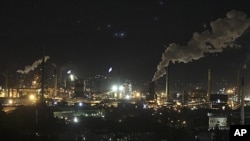Scientists in Australia working on a project to store carbon say they can prove their technology works and is safe. Still, critics say the trial was too small to be decisive.
The scientists working on the carbon sponge project west of Melbourne say that after three and a half years of study, they can now prove that this type of carbon sequestration can work safely.
In March 2008, they began injecting carbon dioxide deep underground near the coastal town Warrnambool in the southern state, Victoria. They have been pumping 65,000 tons of CO2-rich gas into a depleted natural gas reservoir, some two kilometers underground.
The team from Australia’s government-funded Commonwealth Scientific and Industrial Research Organization say there were no signs that carbon dioxide had leaked from its the sealed underground chamber.
Research scientist Charles Jenkins says the process could have a dramatic effect on reducing global greenhouse gas pollution.
“There's a lot of these depleted gas fields that are ideally placed for that. The estimates are that after 2050 you could probably get rid of about two-thirds of the carbon dioxide that's being produced by these big sources," he stated. "So globally it's a very, very significant resource for us.”
Yet despite this optimism, critics have yet to be convinced. They believe the process of storing carbon dioxide underground on any large scale is still too expensive and unreliable.
Arthur Williamson, a professor of chemical engineering at the University of Canterbury in New Zealand, says the Australian survey is not conclusive.
“They have managed to make it work for a short time, on a small scale, in a particular gas field,” he said.
However, proponents of this type of sequestration insist that Australia will not be able to effectively reduce its carbon emissions without the technology.
The process of storing carbon dioxide from power generation and other industrial processes underground was recognized at this month’s climate conference in the South African city, Durban, as a clean development technology.
Australian scientists believe that the capture and storage of CO2 from commercial power stations could be viable by 2020.
Australia is one of the world’s worst per capita producers of gases that many researchers blame for warming temperatures. Farmers and conservative politicians believe that man’s use of fossil fuels is having a negligible effect on the Earth’s climate.







